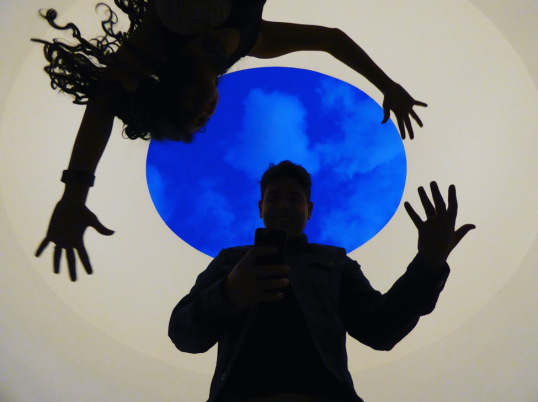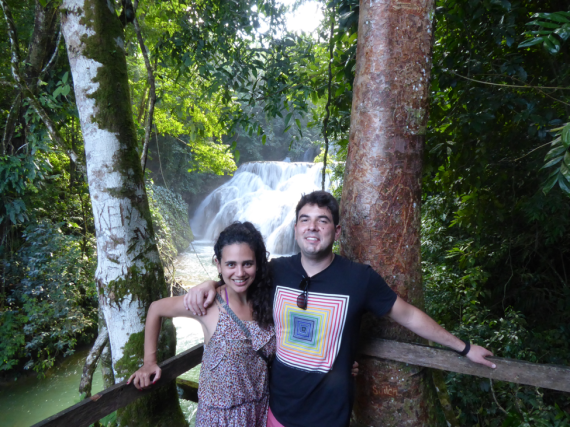My most recent in-flight reading was Thank You for Being Late. In it, Thomas Friedman says risk of AI isn’t that it’s going to take over humanity, HAL-like, but that we as humans could become so entranced by technology that we’ll neglect to teach it human values. It’s not machines v. humans or technology v. creativity. The more technology develops, the greater the opportunity to add to it our kindness, our fairness, and our creativity.
Jorge Castañon, Data Scientist at the IBM Machine Learning Hub and this week’s “You in the Private Cloud,” interviewee, clearly agrees. He and I met this week to discuss math, art, and the future of data science.
What was your first job at IBM?
To understand what data science is. There were so many different definitions! I decided it’s the combination of three things: mathematics, computation, and creativity. You need the creativity to listen to the problem and come up with the math. You need the math because data science requires a very deep understanding of the math that lies behind it. Then you need to compute the solution.
What do you mean, “Listen to the problem?”
Math is like a foreign language that not everyone can speak. When I’m listening to a problem, I’m translating from English to math and then translating back to English to continue the conversation.

The mathematics is distinct from the computation?
Yes. You think of a method mathematically. You eventually need to implement it in the computer: that’s the algorithm part. But first, it’s you and a blank piece of paper, and your thoughts, and eventually a math solution. The first person who thought about linear regression or least squares, that person was mathematical. It was a bunch of data points in space, and then, “Let’s find a model that fits those points” — but first it was math.
IBM was named on Gartner’s Magic Quadrant for Data Science Platforms for 2017, because of DSX with machine learning, and also the work you and the team are doing. A lot of it is side-by-side with clients: what’s that like?
It’s super fun! Learning about new problems is the best part of data science. The minute you start a conversation with a domain expert, to see what are the important parts of the model, what you can use for your math solution: that’s the exciting part. Talking to customers is a way to find the most interesting problems to solve.

I would imagine coming out of Rice with a PhD in Computational Mathematics that you had a lot of career choices. Why did you choose tech and why IBM?
Rice University is in Houston, so there were opportunities in the financial world and the energy sector and a lot of money to be made. I went to a conference and met IBM recruiters and got good indication of the spectrum of expertise at IBM. I felt I would be able to go wherever I wanted to in terms of the research and technical challenges; I would not be limited to one narrow role.
What’s the one thing about work that you are most excited about?
Collaboration. As a computational mathematician, you know a lot about certain things. But to go and talk about energy efficiency, or credit unions, or TV marketing, that gives me new topics where I can apply math and make a difference: to health care for example, or by making a building more efficient.
You are working at the edge of technology that doesn’t quite exist yet.
Definitely. My first project was to identify what is data science: that was unstructured. Then, how to use data science in our products: unstructured. How to apply machine learning: unstructured. It’s very exciting, to find the structure of things that are amorphous or not yet reified. And that’s what mathematics is. It goes back to my whole path, to the creative problem-solving that drives me.

Where do you see data science going? Is it part of the machine learning path, or will it diverge?
It’s an open question as to whether data science is going to be automated and humans won’t be needed. I think they will be. The creativity aspect of data science cannot be automatic.
What do you do for fun outside of work?
I love art, and traveling with my wife: she’s also an applied mathematician. We got to museums and I take photographs of art. I used to do life drawing, but after the PhD and work — you get busy! I love James Turrell in particular; his work is based on what he called “the geometry of light” and he studied math in college.
Customers tell me it’s not just our skills they appreciate, it’s the commitment we make to their success, and they see that from working directly with you and IBMers like you. Thank you.
You are welcome. It is a pleasure to work here. I have a lot of space to grow.
Name: Jorge Castañon
Years at IBM: 3
Home town: Mexico City
Currently working on: IBM Machine Learning Hub
All-time top five artists:
- Francisco Toledo
- James Turrell
- Willem De Kooning
- Mark Rothko
- M.C. Escher
Dinesh Nirmal,
Vice President Analytics Development
Follow me on twitter @DineshNirmalIBM
Enjoyed reading this blog! I wonder if some day we will have a tool similar to Google Translate that does what Jorge’s very smart brain is doing… translating problems expressed in English or Spanish to mathematical algorithms and translating them back. Or is there one out there already?
LikeLike